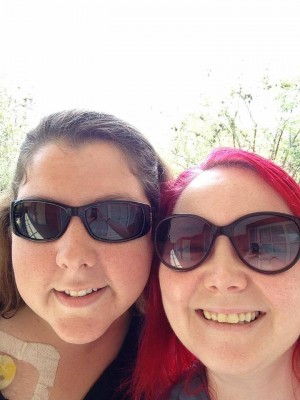Mast cell inhibitory effects of some microorganisms
We have talked recently about how infections can activate mast cells and result in worsening of symptoms in mast cell patients. However, some organisms are actually able to decrease mast cell degranulation and secretion of mediators. Some of these organisms are highly pathogenic with dangerous infectious capabilities, but some are commensal bacteria that can be found in probiotics. These findings support a growing body of evidence that indicates that the changes in our commensal organisms in the last thirty years have contributed to the increased frequency of atopic disease in developed countries. Additionally, improved hygiene and public health have decreased the frequency of some infections, which may also contribute to allergic conditions.
Lactobacillus and Bifidobacteria have been found to directly inhibit mast cell degranulation. Lactobacillus reduces both mast cell degranulation and cytokine secretion by reducing the number of IgE receptors on mast cell surface. Expression of IL-8 and TNF-a are actively decreased, while expression of the anti-inflammatory IL-10 is increased. Bifidobacterium bifidum inhibit IgE activation of mast cells in similar ways.
Salmonella typhimurium is a frequent cause of foodborne illness. In the US, it is estimated to cause 1,000,000 illness events annually, resulting in 19,000 hospitalizations and 380 deaths. It causes diarrhea, fever and severe abdominal cramping that can last several days. A 2001 study found that Salmonella are able to avoid detection by neutrophils through inactivation of local mast cells. Specifically, Salmonella inject a protein known as SptP into the fluid inside mast cells. Following exposure to Salmonella, mast cells lost their ability to degranulate, even when exposed to IgE or strong antigens.
Yersinia pestis, which causes plague, can also suppress mast cell degranulation by injecting a similar protein called YopH. Several forms of commensal E. coli (which do not cause infection) have been found to exhibit similar suppression.
Some organisms can cause mast cells to lyse (burst) and thus die. Pseudomonas aeruginosa releases exotoxin A, which causes lysis of mast cells.
Infectious fungi, such as Aspergillus fumigatus, release a gliotoxin that suppresses mast cell degranulation as well as mediator secretion. Other fungal products that decrease mast cell activity include FK-506 from Streptomyces tsukubaensis and cyclosporine A from Tolypocladium inflatum. Cyclosporine A is often used as an immunosuppressive after organ transplant and also sees some use in treating inflammatory disorders.
Some nematodes (roundworms) are also able to block mast cell degranulation. Filarial nematodes release a molecule, ES-62, that blocks IgE activation of mast cells as well as inhibiting secretion of allergic inflammatory factors. This finding is notable as it provides a possible reason why allergic diseases occur less frequently in developing countries. Toxoplasma gondii, a parasitic protozoan that causes toxoplasmosis, also prevented mast cell degranulation.
References:
Choi, H.W., Brooking-Dixon, R., Neupane, S., Lee, C.-J., Miao, E.A., Staats, H.F., Abraham, S.N., 2013. Salmonella typhimurium impedes innate immunity with a mast-cell-suppressing protein tyrosine phosphatase, SptP. Immunity 39,1108–1120.
Cornelis, G.R., 2002. Yersinia type III secretion: send in the effectors. J. Cell Biol. 158, 401–408.
Magerl, M., Lammel, V., Siebenhaar, F., Zuberbier, T., Metz, M., Maurer, M., 2008. Non-pathogenic commensal Escherichia coli bacteria can inhibit degranulation of mast cells. Exp. Dermatol. 17, 427–435.
Harata, G., He, F., Takahashi, K., Hosono, A., Kawase, M., Kubota, A., Hiramatsu, M.,Kaminogawa, S., 2010. Bifidobacterium suppresses IgE-mediated degranulationof rat basophilic leukemia (RBL-2H3) cells. Microbiol. Immunol. 54, 54–57.
Forsythe, P., Wang, B., Khambati, I., Kunze, W.A., 2012. Systemic effects of ingested Lactobacillus rhamnosus: inhibition of mast cell membrane potassium (IKCa)current and degranulation. PLoS One 7, e41234.
Oksaharju, A., Kankainen, M., Kekkonen, R.A., Lindstedt, K.A., Kovanen, P.T., Korpela,R., Miettinen, M., 2011. Probiotic Lactobacillus rhamnosus downregulates FCER1and HRH4 expression in human mast cells. World J. Gastroenterol. 17, 750–759.
Wesolowski, J., Paumet, F., 2011. The impact of bacterial infection on mast celldegranulation. Immunol. Res. 51, 215–226.
Niide, O., Suzuki, Y., Yoshimaru, T., Inoue, T., Takayama, T., Ra, C., 2006. Fungal metabolite gliotoxin blocks mast cell activation by a calcium- and superoxide-dependent mechanism: implications for immunosuppressive activities. Clin.Immunol. 118, 108–116.
Melendez, A.J., Harnett, M.M., Pushparaj, P.N., Wong, W.S., Tay, H.K., McSharry, C.P.,Harnett, W., 2007. Inhibition of Fc epsilon RI-mediated mast cell responses by ES-62, a product of parasitic filarial nematodes. Nat. Med. 13, 1375–1381.
Hae Woong Choi, Soman N. Abraham. Mast cell mediator responses and their suppression by pathogenic and commensal microorganisms. Molecular Immunology 63 (2015) 74–79.
